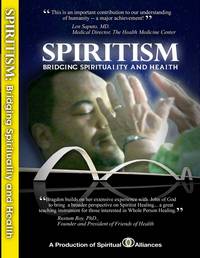Religion and Health: The more we know the more we need to know
Allan Kardec and the Development of a Research Programme in Psychic Experiences
A paper by Professor Alexander Moreida-Almeida presented at the Parapsychological Association & The Society for Psychical Research Convention 2008. Winchester – UK. Proceedings of Presented Papers v.51:327-332, 2008
Psychiatrist Edith Fiore talks about eathbound spirits
Clairvoyant Diagnosis
This experiment assesses the accuracy of a non-medically trained Spiritualist medium in her ability to identify a medically diagnosed disease. The case is also illustrative of the discovery of one earthbound attached spirit and one discarnate entity that uses energy for its own survival that is transmitted by a living human. The dynamic relationship between the disease and the discarnate entities is implied.
Click on the image for a transcription.
Demonic attributions in nondelusional disorders
Abstract
 OBJECTIVE:
OBJECTIVE:
Belief in demonic influence has repeatedly been described as a delusion in schizophrenic patients. The goal of this explorative study was to examine the frequency, as well as the psychodynamic and social functions of such beliefs in a sample of nondelusional patients.
METHOD:
The sample consisted of 343 psychiatric outpatients who described themselves as religious. In semistructured interviews they were asked to give their view of demonic causality of their illness.
RESULTS:
A high prevalence of such beliefs was not only found in schizophrenic patients (56%) but also in the following groups of nondelusional patients: affective disorders (29%), anxiety disorders (48%), personality disorders (37%) and adjustment disorders (23%). Belief in demonic oppression tended to be associated with lower educational level and rural origin, and was significantly influenced by church affiliation.
CONCLUSIONS:
Beliefs in possession or demonic influence are not confined to delusional disorders and should not be qualified as a mere delusion. Rather they have to be interpreted against the cultural and religious background which is shaping causal models of mental distress in the individual.
- PMID:
- 10494064
- [PubMed – indexed for MEDLINE]
Comparison of brazilian spiritist mediumship and dissociative identity disorder
Abstract
 We studied the similarities and differences between Brazilian Spiritistic mediums and North American dissociative identity disorder (DID) patients. Twenty-four mediums selected among different Spiritistic organizations in São Paulo, Brazil, were interviewed using the Dissociative Disorder Interview Schedule, and their responses were compared with those of DID patients described in the literature. The results from Spiritistic mediums were similar to published data on DID patients only with respect to female prevalence and high frequency of Schneiderian first-rank symptoms. As compared with individuals with DID, the mediums differed in having better social adjustment, lower prevalence of mental disorders, lower use of mental health services, no use of antipsychotics, and lower prevalence of histories of physical or sexual childhood abuse, sleepwalking, secondary features of DID, and symptoms of borderline personality. Thus, mediumship differed from DID in having better mental health and social adjustment, and a different clinical profile.
We studied the similarities and differences between Brazilian Spiritistic mediums and North American dissociative identity disorder (DID) patients. Twenty-four mediums selected among different Spiritistic organizations in São Paulo, Brazil, were interviewed using the Dissociative Disorder Interview Schedule, and their responses were compared with those of DID patients described in the literature. The results from Spiritistic mediums were similar to published data on DID patients only with respect to female prevalence and high frequency of Schneiderian first-rank symptoms. As compared with individuals with DID, the mediums differed in having better social adjustment, lower prevalence of mental disorders, lower use of mental health services, no use of antipsychotics, and lower prevalence of histories of physical or sexual childhood abuse, sleepwalking, secondary features of DID, and symptoms of borderline personality. Thus, mediumship differed from DID in having better mental health and social adjustment, and a different clinical profile.
- PMID:
- 18477886
- [PubMed – indexed for MEDLINE]
Scientific and Medical Network Annual Gathering 2014
Consciousness and the Experience of Time
MYSTICS AND SCIENTISTS
4 April 2014 – 6 April 2014
Venue: University of Warwick
The Mystics and Scientists conferences have been held every year since 1978, and are dedicated to forging a creative understanding of the complementary roles of scientific and mystical approaches to reality. The conferences always provide a highly engaging and creative opportunity to come together with like-minded people in a spirit of exploration and dialogue. This year we are looking at various aspects of our conscious experience of time, drawing on physics, neuroscience, philosophy, phenomenology, psychology and parapsychology. Bernard Carr, Natalie Depraz and Barbara Magnani have different approaches to the relationship between physical and psychological time, while Jacob Needleman considers the spiritual mystery of time in relation to the practical problem of time. David Luke asks if we can in some sense transcend time in precognition. James d’Angelo and David Lorimer offer an experience of music, rhythm, movement and dance. We greatly look forward to your participation.
Complementary spiritist therapy: systematic review of scientific evidence.
 Abstract
Abstract
Spiritism is the third most common religion in Brazil, and its therapies have been used by millions worldwide. These therapies are based on therapeutic resources including prayer, laying on of hands, fluidotherapy (magnetized water), charity/volunteering, spirit education/moral values, and disobsession (spirit release therapy). This paper presents a systematic review of the current literature on the relationship among health outcomes and 6 predictors: prayer, laying on of hands, magnetized/fluidic water, charity/volunteering, spirit education (virtuous life and positive affect), and spirit release therapy. All articles were analyzed according to inclusion/exclusion criteria, Newcastle-Ottawa and Jadad score. At present, there is moderate to strong evidence that volunteering and positive affect are linked to better health outcomes. Furthermore, laying on of hands, virtuous life, and praying for oneself also seem to be associated to positive findings. Nevertheless, there is a lack of studies on magnetized water and spirit release therapy. In summary, science is indirectly demonstrating that some of these therapies can be associated to better health outcomes and that other therapies have been overlooked or poorly investigated. Further studies in this field could contribute to the disciplines of Complementary and Alternative Medicine by investigating the relationship between body, mind, and soul/spirit.
Click on the image for the online paper.




